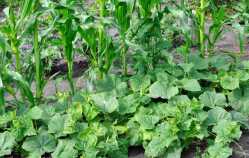Companion Planting and Attracting Pollinators to Your Backyard Garden

Companion planting is the theory that plants/crops which are planted close in proximity can benefit from each other in several ways including: nutrient uptake, water regulation, pest management, enhanced pollination and overall better yield potential. This theory has been used for hundreds, if not thousands, of years by the Native American communities as well as other cultures around the world.
Some are examples of companion planting that have been proven to work include utilizing the “Three Sisters” – corn, beans and squash. Corn provides the stalks for the beans to “climb” while the sprawling squash vines provide cover for water and weed management. Beans, as well as other legumes, can fix atmospheric nitrogen because of bacterial root nodules on their roots – providing the most essential plant nutrient to both the corn and squash plants. Another beneficial group of crops to plant together are: carrots and onions, tomatoes and basil or radishes and cucumbers. Planting peas or beans in random spots within your garden area may also help spread valuable nitrogen to other parts of the garden bed for use by other plants.
Though companion planting is “anecdotal”, there is scientific evidence from other plant systems that below the soil emit numerous chemical cues from their root systems, which may directly or indirectly help (or hurt) other nearby plants.
For the full story, pick up a copy of the Mountain Home News or click on this link to subscribe to the newspaper's online edition.
